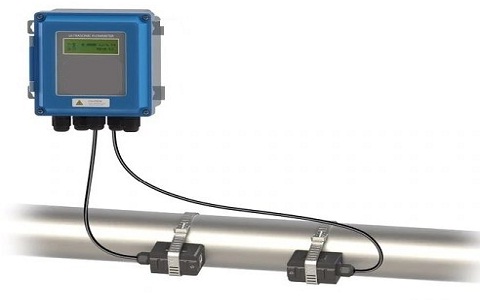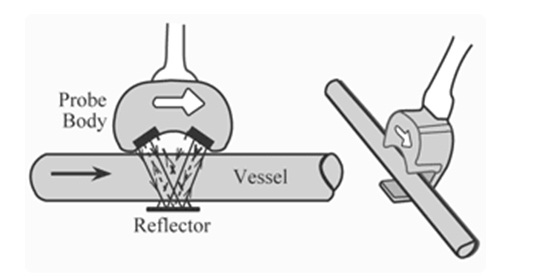
The first ultrasonic flow meter was invented by Japanese physicist namely “Shiego Satomura” in the year 1959. This flow meter uses Doppler technology and the main intention of this meter is to deliver the analysis of blood flow. After four years, the earliest flow meters have appeared in industrial applications. At present, there are many manufacturing companies were designing different types of clamp-on flow meters to measure the liquid flow within a pipe. These meters use high-frequency sensors by penetrating throughout the pipe wall as well as the liquid by using Doppler otherwise transit time propagation method. So that fluid velocity and flow rate can be determined.

Definition: An ultrasonic flow meter can be defined as, a meter that is used to measure liquid velocity with ultrasound to analyze the volume of liquid flow. This is a volumetric flow meter that needs bubble or minute particles within the liquid flow. These meters are suitable in the applications of wastewater but they will not work with drinking/distill water. So this type of flow meter is ideal for the applications wherever chemical compatibility, low maintenance, and low-pressure drop are required. These meters will affect the audio properties of the liquid and also impact through viscosity, density, temperature, etc. Like mechanical flow meters, these meters do not include moving parts. The price of these meters will change greatly so frequently it can be used and maintained at a low cost.

An ultrasonic flow meter construction can be done by using upstream and downstream transducers, sensor pipe and reflector. The working principle of ultrasonic flow meter is, it uses sound waves to resolve the velocity of a liquid within a pipe. There are two conditions in the pipe like no flow and flowing. In the first condition, the frequencies of ultrasonic waves are transmitted into a pipe & its indications from the fluid are similar. In the second condition, the reflected wave’s frequency is dissimilar because of the Doppler Effect. Whenever the liquid flows in the pipe quickly, then the frequency shift can be increased linearly. The transmitter processes the signals from the wave & its reflections determine the flow rate. Transit time meters transmit & receive ultrasonic waves in both the directions within the pipe. At no-flow condition, the time taken to flow in between upstream & downstream in between the transducers is the same. Under these two flowing conditions, the wave at upstream will flow with less speed than the downstream wave. As the liquid flows faster, the distinction between the up & downstream times raises. The times of the upstream & downstream processed by the transmitter to decide the flow rate.
The advantages are
The disadvantages are
The applications of ultrasonic flow meters include the following.
1). What is ultrasonic measurement?
Ultrasonic measurement is the contactless principle and used for measuring the levels of corrosive, boiling and hot liquids.
2). How accurate are ultrasonic flow meters?
These meters provide extremely good accuracy and work well for dirt free flow otherwise liquid flow with small particles.
3). What is the most accurate flow meter?
Coriolis mass flowmeters generate the most precise for most liquids but they are costly.
4). What is a Doppler flow meter?
The Doppler flow meter use reflected ultrasonic noise to determine the liquid velocity.
5). Who invented ultrasonic flow meter?
It was developed by Shigeo Satomura in the year 1959 for analysis of blood flow and in 1963, the first meter was developed for industrial applications.
Thus, this is all about an overview of the ultrasonic flow meter. From the above information finally, we can conclude that these meters are becoming more popular because they are very simple to use and it is not essential to slash a pipe to attain precise liquid flow measurements. These are suitable for measuring both water and oil-based liquids. Here is a question for you, what is a clamp-on ultrasonic flow meter?